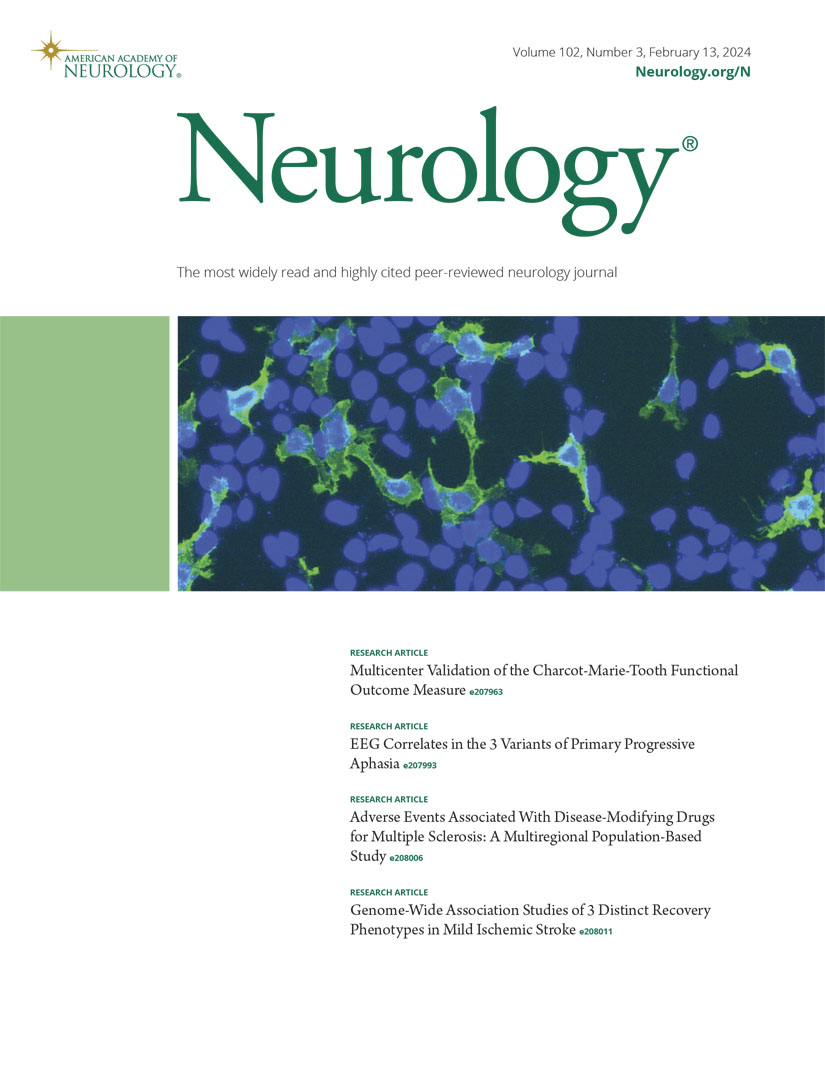Long-Term Consumption of Ultraprocessed Foods and Prodromal Features of Parkinson Disease.
IF 7.7
1区 医学
Q1 CLINICAL NEUROLOGY
引用次数: 0
Abstract
BACKGROUND AND OBJECTIVES Consumption of ultraprocessed foods (UPFs) has been associated with a higher risk of various chronic diseases, but its relation to prodromal Parkinson disease (PD) remains unclear. We aimed to assess the association between long-term UPF consumption and nonmotor features suggestive of prodromal PD. METHODS This longitudinal analysis included participants without a history of PD from the Nurses' Health Study and Health Professionals Follow-Up Study. UPF consumption was assessed using repeated food frequency questionnaires (1984-2006) and grouped based on Nova classification. Participants provided data on probable REM sleep behavior disorder (pRBD) and constipation in 2012. Between 2014 and 2015, a subset of participants provided data on 5 additional nonmotor features, including hyposmia, impaired color vision, excessive daytime sleepiness, body pain, and depressive symptoms. The primary outcome was the combination of all 7 prodromal features and further categorized as 0 (reference), 1, 2, and ≥3 features. The secondary outcomes were all features except constipation, a combination of 3 commonly recognized features (constipation, pRBD, and hyposmia), and individual features. Multinomial logistic regression was used to estimate the association of UPF consumption with the combination of prodromal features. The association between UPF consumption and each individual feature was further examined using logistic regression. RESULTS The study analyzed 42,853 participants (25,095 women [58.6%]; mean [SD] age, 47.8 [5.2] years). Comparing extreme quintiles of UPF consumption, the multivariable-adjusted odds ratio (OR) for having ≥3 vs 0 prodromal features was 2.47 (95% CI 1.89-3.23, ptrend < 0.0001) for cumulative average intake and 1.50 (95% CI 1.18-1.89, ptrend = 0.0009) for baseline intake. Similar results were observed for combinations of all features except constipation (OR 2.00, 95% CI 1.29-3.11, ptrend < 0.0001) and combinations of 3 features (OR 2.47, 95% CI 1.41-4.34, ptrend = 0.008). In addition, higher UPF consumption was associated with increased odds of individual prodromal features, including pRBD, constipation, body pain, and depressive symptoms. DISCUSSION Long-term UPF consumption was positively associated with nonmotor prodromal PD features. More studies are warranted to confirm whether lowering UPF consumption may prevent the occurrence of nonmotor symptoms that often precede PD diagnosis.长期食用超加工食品与帕金森病前驱症状的关系
背景和目的超加工食品(upf)的消费与各种慢性疾病的高风险相关,但其与前驱帕金森病(PD)的关系尚不清楚。我们的目的是评估长期UPF消耗与提示前驱PD的非运动特征之间的关系。方法本纵向分析纳入了来自护士健康研究和卫生专业人员随访研究的无PD病史的参与者。使用重复食物频率问卷(1984-2006)评估UPF消费,并根据Nova分类进行分组。参与者在2012年提供了可能的快速眼动睡眠行为障碍(pRBD)和便秘的数据。在2014年至2015年期间,一部分参与者提供了5项额外的非运动特征的数据,包括睡眠不足、色觉受损、白天过度嗜睡、身体疼痛和抑郁症状。主要结局是所有7个前驱特征的结合,并进一步分为0(参考)、1、2和≥3个特征。次要结局包括除便秘外的所有特征、3种常见特征(便秘、pRBD和低体温)的组合以及个体特征。使用多项逻辑回归来估计UPF消耗与前驱症状组合的关联。UPF消耗与每个个体特征之间的关联使用逻辑回归进一步检验。结果该研究分析了42,853名参与者(女性25,095名,占58.6%);平均[SD]年龄47.8[5.2]岁)。比较UPF消耗的极端五分位数,累积平均摄入量的多变量调整优势比(OR)为2.47 (95% CI 1.89-3.23, ptrend < 0.0001),基线摄入量的多变量调整优势比(OR)为1.50 (95% CI 1.18-1.89, ptrend = 0.0009)。除了便秘(OR 2.00, 95% CI 1.29-3.11, ptrend < 0.0001)和3个特征的组合(OR 2.47, 95% CI 1.41-4.34, ptrend = 0.008)外,所有特征的组合也观察到类似的结果。此外,较高的UPF消耗与个体前驱症状的几率增加有关,包括pRBD、便秘、身体疼痛和抑郁症状。长期UPF消耗与PD的非运动性前驱特征呈正相关。需要更多的研究来证实降低UPF消耗是否可以预防PD诊断前经常出现的非运动症状的发生。
本文章由计算机程序翻译,如有差异,请以英文原文为准。
求助全文
约1分钟内获得全文
求助全文
来源期刊

Neurology
医学-临床神经学
CiteScore
12.20
自引率
4.00%
发文量
1973
审稿时长
2-3 weeks
期刊介绍:
Neurology, the official journal of the American Academy of Neurology, aspires to be the premier peer-reviewed journal for clinical neurology research. Its mission is to publish exceptional peer-reviewed original research articles, editorials, and reviews to improve patient care, education, clinical research, and professionalism in neurology.
As the leading clinical neurology journal worldwide, Neurology targets physicians specializing in nervous system diseases and conditions. It aims to advance the field by presenting new basic and clinical research that influences neurological practice. The journal is a leading source of cutting-edge, peer-reviewed information for the neurology community worldwide. Editorial content includes Research, Clinical/Scientific Notes, Views, Historical Neurology, NeuroImages, Humanities, Letters, and position papers from the American Academy of Neurology. The online version is considered the definitive version, encompassing all available content.
Neurology is indexed in prestigious databases such as MEDLINE/PubMed, Embase, Scopus, Biological Abstracts®, PsycINFO®, Current Contents®, Web of Science®, CrossRef, and Google Scholar.
 求助内容:
求助内容: 应助结果提醒方式:
应助结果提醒方式:


